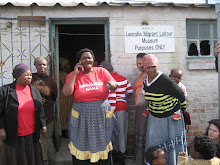This followed a visit the previous weekend by industrial archaeologist David Worth who has previously worked on aspects of the AECI site and other buildings in the Helderberg area as well as having extensive knowldege and experience of international debates in this field.

27 February 2010, industrial archaeologist David Worth (centre) and LMLM staff set off walking to Hostel 33.
Photograph by Noeleen Murray.
The intention of both visits was to gather insights and expert views on some of the challenges presented by the restoration projects.
Some aspects of the discussions were as follows:
- There was general agreement that the documentation of the space in its current state needs to be meticulously recorded. Methodologies were discussed in relation to augmenting the condition report and useful insights noted around the merits of using archaeological methods as well as detailed drawings and annotated photographs to document each sub-section systematically and to record details of items added by residents of the spaces over time.
- David Worth suggested that we might consider remote sensing by a Geomatics Engineer as an alternative recoding method.
- William Martinson was struck by the authenticity of the space, citing how rare a heritage resource the hostel is, which should be approached with utmost sensitivity. He cited the relevance in this case of the Burra Charter principle of: "Doing less to the fabric (of any heritage resource) is to be favoured, rather than more. The fabric of the place should be allowed to tell its own story, even if some of the physical evidence of that story has gone. Keeping change to a miniumum protects the evidence of history....This approach is different from the popular understanding of 'restoration' as an act of heroic change, intended to return a place to its former glory.' Dramatic transformations, which shock and astonish with their revelations, are not preculded. But the value of a place as a complex and genuine entity should be upheld to encourage the retention of layers of complexity which are easily lost during radical change" (cited from Marquis-Kyle, P and Walker M, The Illustrated Burra Charter: Making Good decisions about the care of important places, Australia ICOMOS, 1996)
- Jerry Roger's responses to queries about the building fabric echoed this and his suggestion was for as little intervention as possible, noting that structural cracks and the like were old and had settled and presented no current risk to the strucure.
- All agreed that as David Worth stated "I suspect the roof is not the problem you might think it is." The consensus view here is that replacing the roof would destroy the heritage resource and that cleaning, painting or disturbing the roof would render the white asbestos dangerous. As there are no major leaks and given that the roof sagging was probably due to previous loading the approach would be to leave it as is. Also William noted that the black ceilings were an important part of the quality of the space and cleaning these would alter this in problematic mays. He also cautioned against other readical forms of cleaning citing that in his experience hostel structures were not very clean, often marked by black ceilings and other traces of heavy use through overcrowding. While personal effects might have been kept clean, more communal spaces and the actual buildings were/are not.
- The removal of the new waterborne sewerage and fixtures was supported by all.
- The importance of restoring and fixing the bucket system area was also noted and caution was expressed with regard to using a carefull bricklayer to attend to the masonry work. The rebuilding of a new wall structure at the entrance to the area (which would be obviously marked as new in some way) was supported.
- Discussions were held about the best ways to rewire the place and it was felt that non intrusive approaches would be used, perhaps even reusing the existing electrical conduiting or running new insulated wiring along these were proposed.
- The exterior of the building, all felt, was another area where not much should be done, as this would be difficult to justify and that it is in reasonably good condition as is. It was suggested that this was an instance of the need to monitor and only act if it becomes necessary.
- The removal of the new concrete apron at the entrance side of the hostel was supported but that this should be done with care and attention to looking for evidence of previous structures which may still be present below the current surface. Also the washing lines, verandah poles, the shed and the car port should be removedand relcoated in consultation with neighbouring residents.




